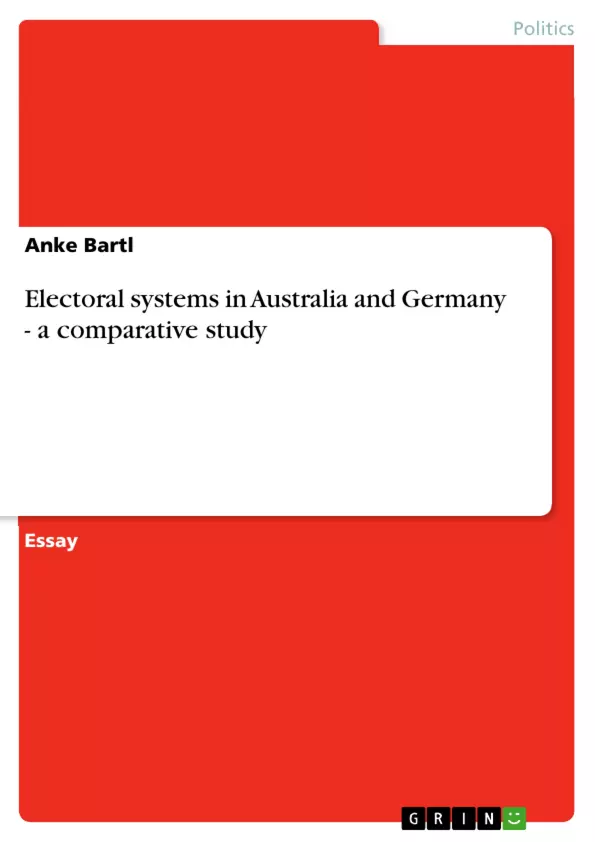This essay aims to explain the differences between preferential and proportional
systems of voting and the consequences of these systems in Australia. The
electoral system of Germany is examined in comparison.
Why are electoral systems so important? Through elections, citizens of a county
can express their views and choose the government they wish to see in power.
Therefore, the electoral system is one of the significant features of a democracy
and a representative government. The political outcome of an election can vary
greatly depending on which of the different types (and/or variations of each type)
of systems is in effect. Hence, the organisation of the political system strongly
depends on the electoral system.1
The impacts of electoral systems on the political and party system will be
examined after looking at the two systems of voting used in Australia at the
Commonwealth/ Federal level: the preferential voting system and the system of
proportional representation.
Preferential voting in single-member seats is used for elections for the House of
Representatives and is also often referred to as Alternative Vote.2 A distinctive
feature of this voting system is that the winning candidate needs to receive an
absolute majority of the primary vote, in other words 50% plus one. Alternatively,
the candidate can win the election by securing an absolute majority after the
distribution of preferences. 3
Under a system of full preferential voting, electors must indicate a preference for
all candidates listed on the ballot paper. Voters show their first preference by
giving the number “1” to their preferred candidate. They then rank all other
candidates by distributing the remaining numbers in descending order from 2 to X
(X = the number of candidates taking part in the election).
In the first round of counting votes, the numbers of primary votes are registered. [...]
1 David W. Lovell et al., The Australian Political System, (2nd edition), Longman, South
Melbourne, 1998, p. 269.
2 Ben Reilly, ‘The Alternative Vote in Australia’, 6 March 1999, Electoral Systems,
Administration and Cost of Elections Project, <http://www.aceproject.org/main/english/es/>;,
consulted 2 June 2003
Table of Contents
- Introduction
- Preferential voting
- Proportional representation
- Three main types of proportional representation
- Impacts of the electoral systems in Australia
- Impacts of the electoral systems in Germany
- Conclusion
Objectives and Key Themes
This essay aims to analyze and explain the differences between preferential and proportional voting systems, examining their consequences in the Australian political system. The German electoral system is studied as a point of comparison.
- The significance of electoral systems in democratic societies
- The impact of different voting systems on political outcomes
- The relationship between electoral systems and party structures
- The strengths and weaknesses of preferential and proportional representation
- The Australian and German electoral systems as case studies
Chapter Summaries
The first chapter introduces the subject matter and highlights the significance of electoral systems in shaping democratic processes and political outcomes. The second chapter delves into the preferential voting system, outlining its characteristics and operation, including the concept of alternative voting. The third chapter focuses on proportional representation, highlighting its aim of achieving proportional seat distribution based on party support.
The chapter examines the different types of proportional representation and how the single transferable vote system operates in Australia.
Keywords
The core focus of this work is on the contrasting electoral systems of preferential voting and proportional representation. Key concepts include: democratic representation, political outcomes, party systems, alternative voting, single transferable vote, majoritarian systems, multi-member electorates, and electoral reform.
- Quote paper
- Anke Bartl (Author), 2003, Electoral systems in Australia and Germany - a comparative study, Munich, GRIN Verlag, https://www.grin.com/document/17701



